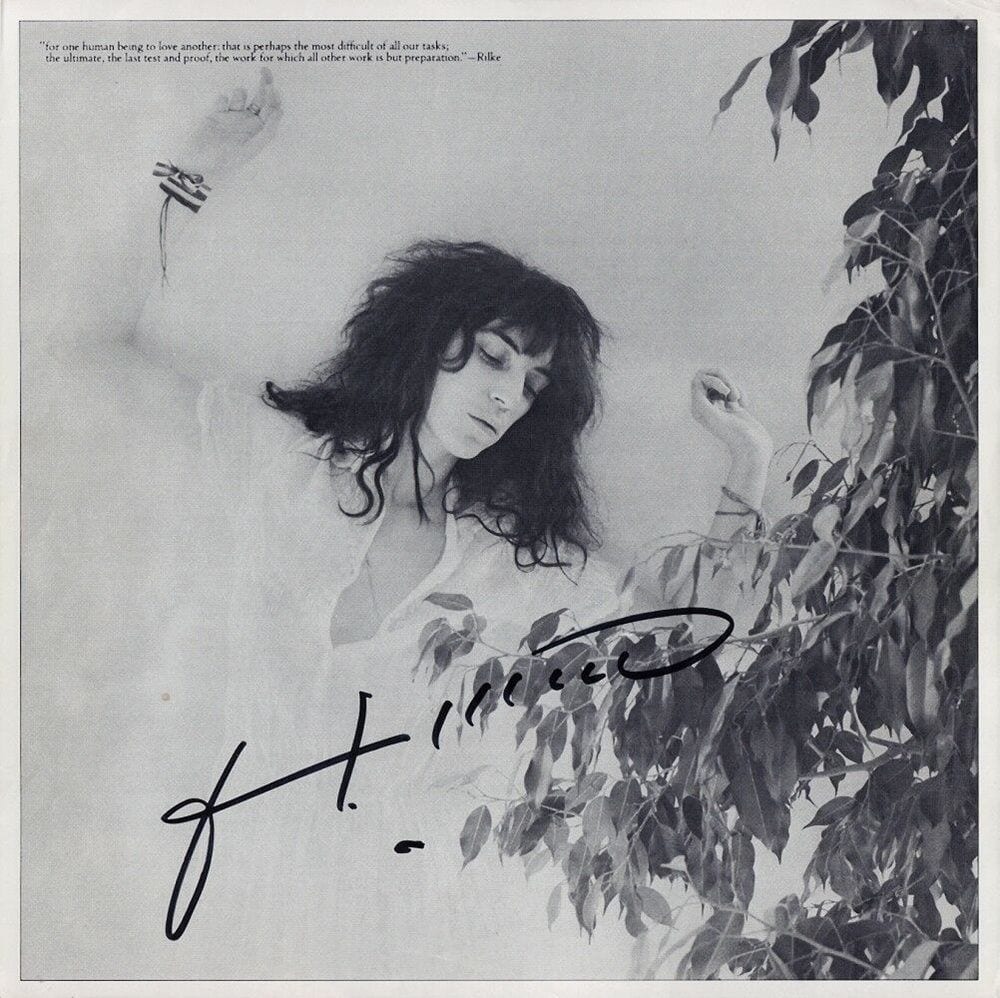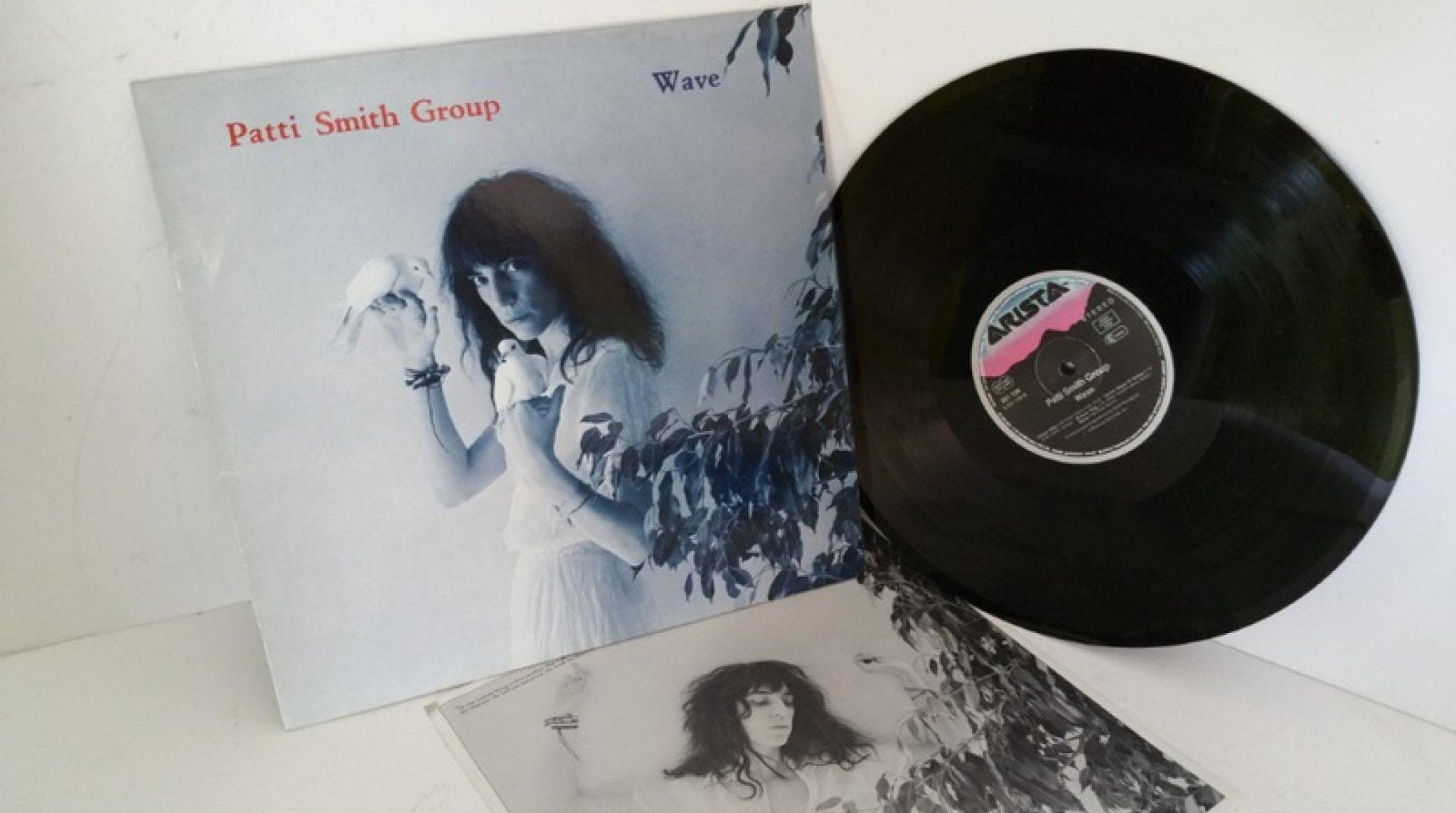
“Sanitized, prettified… a manipulative commercial tease,” Tom Carson wrote of Patti Smith’s album Wave, in his 28 June 1979 review for Rolling Stone. Oppositional to much of the critical acclaim she had received until that point, his was a harsh assessment, but not an unpopular one.
Smith’s 1975 debut Horses was revolutionary for its bravery. The chutzpah required to weave garage rock aesthetics with spoken word (practically inventing the punk genre) denoted an unparalleled feat from a major label and a bold move from a relative unknown who had spent the past decade eking it out on the coffeehouse circuit. Radio Ethiopia (1976), her sophomore album, continued in that abstract tradition. Meanwhile, its follow-up Easter (1978) saw Smith’s creative synergy reach the peak of its powers—in art and accessibility—with the hit single “Because the Night” co-written with Bruce Springsteen. The album affirmed its singer’s status as one of the preeminent female rockers of the 1970s and an internationally-renowned pop crossover.
Wave, Smith’s fourth studio LP, continues in the latter’s “radio-oriented” tradition but has managed to live in its shadow. That’s mainly because of the perception that Smith had “sold out” to a mainstream audience, and in doing so, abandoned the DIY punk base of which she was the biggest vanguard. Mixed feelings regarding Smith’s quaternary effort, as reflected in Carson’s summation, remain. But deriding Wave for reasons of “pandering” is to misunderstand Smith’s ethic as an artist and musician entirely.
Light bulb by ColiNOOB (Pixabay License / Pixabay)
In her PopMatters review for Smith’s latest book Year of the Monkey, writer Megan Volpert asks, “Would we allow Smith to become an actor? Would we allow Smith a third act at all? In some ways, the ‘godmother of punk’ has not been allowed space for a proper second act.” For a career founded on sound and stardom at first unclassifiable—Smith’s gendered-averse performance mythology both transformed and trampled industry standards—classification has, ironically, proven one of her biggest hurdles in the long view.
Volpert challenges our collective propensity towards bridling Smith’s oeuvre under a single “truth”, noting that before she ever set foot into a recording studio, Smith worked as a full-time writer. Music was the nighttime hobby of a daytime poet, and Horses was the brilliant but accidental result of balladry-and-rock confluence. Paradoxically, from one of the most structurally-amorphous and sonically-defiant records of the 1970s, has been borne a commoditized, almost capitalistic legacy. It has trapped Smith in a branded cultural position (with the honorific “punk poet laureate”) that remains untrue to the subversive and unceasing ethos of her artistry.
For Smith, success is a transient and subjective construct, even when it is tangible. Radio Ethiopia sold next-to-nothing, but Smith still performs many of its songs on her concert tours. Simultaneously, an embrace of the lesser-known singles does not color her engagement with the more commercially-viable cuts of her canon, which Smith performs with equal pride and importance. She feels no greater loyalty to the punk underground, and its rejection of mainstream tastes, than she does to the lucrative pop realm, and its rejection of indie insurrection.
Instead, Smith evades clout both commercial and contrarian, surveying her craft as an immaterial phenomenon with the freedom to float through phases—from the back catalogue of the CBGB Record Canteen, to the top of the Billboard charts—with little concern for the ebbs and flows it encounters on its journey. “I don’t think she’s ever done anything to be successful. I think she’s only done things to express herself,” commented Rolling Stone staffer David Wilde in a recent Biography special (see here on YouTube).
An agenda for celebrity seems incompatible with this mythology, and Smith in no way touted such intentions. But when the opportunity for Top 40 radio-play came knocking at her door, she did not turn up her nose. Pop was another medium, not a means to an end. Like everything else, it merely marked the next step in her ongoing creative pilgrimage: “I’m always the same person. I evolve, but I don’t change for any material reason…if I could, I’d write the hit of the world” she noted on Skavlan in 2017 (see here on YouTube).
That dream was realized in “Because the Night”, Smith’s biggest chart success to date, ranked among NME‘s Top 150 Singles of All Time. On the other hand, its album Easter upholds a controversial hard rock sensibility galvanized by Christian fixations, and Smith’s characteristic coalescence of the “sanctified” and “vulgar”, reaffirming Wave‘s status as her most unapologetically-pop effort. Ironically, this reality reveals the most authentically “punk” gesture of the artist’s career: rejecting the idea that her genre capabilities begin and end with that four-letter word. She is neither the pop-star nor the punk-star; she is boldly and freely, Patti Smith, creator-at-large.
In a label-reliant market, Smith’s aims may have been misunderstood. As the punk scene lost steam, and Easter sales tapered inevitably, bands like hers, once acclaimed for their radicalism, began contending with dislocation, unable to be “housed” within a certain industry trend. Thus, when synth and new wave sonics foreshadowed major changes in music come 1979, Wave read as a “safe” pop record churned out during a major transitional moment. Such a move can be sincere but may also make an artist an easy target for “sell-out” slander. The Patti Smith Group was a band borne of punk, and embraced unexpected chart success on their third album with an intoxicating mix of celebrant gratitude and Beatnik-brand “coolness”. Releasing a follow-up LP as polished as Wave, amid the death knells of the genre that defined their rugged formative sound, registered for critics as both a betrayal and a copout.
Forty years later, one realizes the blinkered nature of this assessment. Wave is the most unexpected and rewarding item of Smith’s catalogue because it remains flippant to what most listeners would have deemed a “respectable” move. Greeting Easter’s surprise mainstream success with hostility and returning to the dying punk roots as a means of rendering oneself the rebellious and enlightened martyr of that vanishing “higher art”. Smith was rock’s insubordinate beating heart, was she not? Spitting, screaming, vaulting off stages, and kicking holes in drum sets. Surely she viewed her brief time in the world of “pop bourgeoisie” with cynicism. On Wave, she makes the most shocking proclamation of her career by refuting that very assumption. Pop star status wasn’t so bad, she tells us, and it certainly wasn’t something to be ashamed of. It exists on no higher or lower plane of “art” than punk because for Smith, art remains a properly unclassifiable, and intrinsically personal, wonder.
Wave, then, emerges as her most personal album. The opening track and lead single “Frederick” failed to enter the Billboard Top 40 amid Arista Records’ lackluster promotional efforts. But the song sees Smith at her giddiest and most exposed. While future husband Fred “Sonic” Smith provided lyrical inspiration for “Because the Night” a year before, Smith’s beau is never named in the song. Here, she shamelessly discloses her inamorato’s identity with the kind of enthusiasm only true love could engender.
The singer’s early career image, typified by androgyny, made way for a masculinized public perception at once liberating, but eventually, as limiting as the feminized trappings she initially feared. On “Frederick”, she is unapologetically feminine, finally asserting the unfettered fluidity of her persona. The song also evades genre pigeonholing, separate from Smith’s performance, with a rock-meets-disco concoction effectively accented by infectious new wave synth riffs. It is an opening that’s equal parts brave and beautiful.
“Dancing Barefoot”, on the other hand, embraces a catchy rock sensibility that concurrently points to the future of the genre. Lyrically reflective (as an homage to women like Jeanne Hébuterne), but musically prophetic, Wave’s second track finds auditory contiguity with the early 1990s U2 deep cuts. Its success at embodying a kind of sonic futurism while staying so firmly woven into the album’s late 1970s fabric speaks volumes of Smith’s malleable approach to music-making. That it would actually become a deep cut for U2, as a cover on their Best of 1980-1990 retrospective, only validates the single’s pop prescience. Rolling Stone would later choose “Dancing Barefoot” as one of its 500 Greatest Songs of All Time.
Track three, a re-imagination of the Byrds’ “So You Want to Be (A Rock ‘n’ Roll Star)”, is arguably the album’s most galvanizing expression. Smith repurposes the song’s sardonic message— “the price you paid for your riches and fame, was it all a strange game? You’re a little insane”—with the anthemic interlude: “Hey you, come here! Get up! This is the era where everybody creates!” The high priestess of punk, rejecting cynicism, feeling sanguine? You bet.
Wave thusly presents a triptych of skillfully constructed pop vigor in its first act, establishing an utterly addictive sound. Still, Smith feels uninhibited at venturing into darker fare. Her ability to draw from wells pertinent and philosophical, and still make the music unapologetically listenable, is where Wave’s biggest accomplishment lies.
“Hymn” offers a shamanistic reprieve, acknowledging Smith’s poetic roots and religious obsessions (an idiosyncratic moment, and one of the album’s most surreal), before capping its A-side, brilliantly, with “Revenge”. It is the axis on which her LP spins, a purply, howling, guitar-shredding meditation on rage and rebirth that first reads as another Smithian ramble (akin to “Birdland” or “Land: Horses/Land of a Thousand Dances/La Mer (De)”. But it surprises listeners with a shimmering pop veneer indicative of Smith’s calculative artistic control—rejecting long-windedness, even as it transcends the five-minute mark, to make every second of those five minutes feel deliciously worthwhile.
“Citizen Ship” maintains the momentum, as Smith dabbles in the broader sociological imagination amid issues of immigration and displacement, inexplicably, a point of irritation for critics 40 years ago. “There were tags all over my sleeve, there was water outside the windows, and children in the streets… citizen ship we got memories, stateless, they got shame. Cast adrift from the citizen ship, lifeline denied, exiled this castaway.” It plays into the fluidity of both lived experience and vernacular (citizenship versus citizen ship), her poetics offering personal introspection and topical urgency in equal measure. Most viewed this aesthetic choice as a pretentious diversion. We see now, four decades on, how Smith’s work would prove far more prophetic than pretentious.
“Seven Ways of Going” hurls listeners into the album’s third act, and is also its darkest number, a primal exercise in stochastic murkiness. The piano-laden “Broken Flag” follows. Smith crows to life a somber yet rousing meditation. “And we marched on toward Algiers…in the sky a broken flag, children wave and raise their arms. We’ll be gone, but they’ll go on and on…”. Therefore, opening the LP’s doors to further sociological exploration and playing into the pathos of tragedy and human resilience.
The title track, however, ends our pop-oriented voyage with complete experimentalism. From the melodic folds, we are awoken. The spoken word artist, who so deftly mixes divinity and blasphemy, hasn’t left us yet. Here, Smith poetically delineates the papacy and passing of Pope John Paul II in jarring first-voice, confronting hero worship, the comforts of spirituality, and the smokescreen of organized religion “Hi. I was running after you for a long time / I like to watch you when you’re walking / And the way your cloth looks / It really made me happy. And. Um. I just wanted to thank you / Goodbye. Goodbye, sir. Goodbye, papa.”
Transforming from a confident woman in love on track one, to an almost infantile state of mind on track nine, Smith returns to her avant-garde roots (or has she been there all along?), where assured proclamations end in garbled words, sexual freedom melts into divine adulation, and sky-high success still inevitably brings us back to earth.
Read beginning-to-end and end-to-beginning, Wave is the microcosm of the artist’s journey back to punk from pop, and into pop from punk. That journey operates, fluidly, on both planes. After all, Smith does not, and never will exist, classifiable. And like Smith, her fourth LP cannot be easily classified as just another “run-of-the-mill” pop album. Rather, it remains a rich, multicolored soundscape of contemplation and catharsis that upholds unexpected radio appeal at the same time—an almost inconceivable feat in a vehemently categorical industry.
Patti Smith was not simply riding the Wave of success. Wave, as it would be, evaded Easter‘s fluky, chart-climbing fate for brasher, fuller-realized experimentation unlike anything her band had done before: a shameless, self-reflexive dabble in a radically-mainstream sound.
Sources Cited
“Wave”, Tom Carson, Rolling Stone, 28 June 1979
“Patti Smith’s ‘Year of the Monkey’: Is She Evolving? Are We?”, Megan Volpert, PopMatters, 2 October 2019
“NME Writers All-Time Top 150 Singles”, 28 February 1987
- Patti Smith Is Some Messed Up Kind of Saint - PopMatters
- Patti Smith's 'Year of the Monkey': Is She Evolving? Are We ...
- The New Jerusalem by Patti Smith (book review) - PopMatters
- How Kate Bush and Patti Smith Immortalized Wilhelm Reich in Song ...
- Patti Smith's Practice of Everyday Living Will Intrigue Readers of 'M ...
- Patti Smith: Outside Society - PopMatters
- Patti Smith: Banga - PopMatters
- Counterbalance No. 19: Patti Smith's 'Horses' - PopMatters
- Counterbalance 19: Patti Smith -'Horses' - PopMatters




